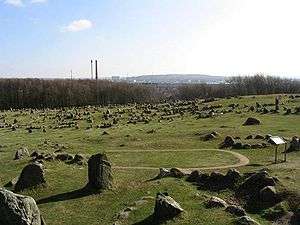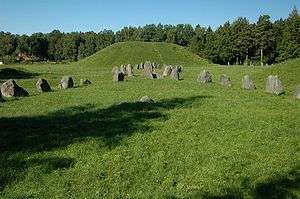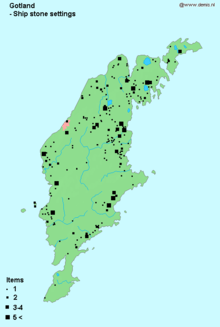Stone ship

The stone ship or ship setting was an early burial custom in Scandinavia, Northern Germany and the Baltic states. The grave or cremation burial was surrounded by slabs or stones in the shape of a ship. The ships vary in size and were erected from c. 1000 BC to 1000 AD.
History
Stone ship were an early burial custom, characteristically Scandinavian but also found in Northern Germany and the Baltic states. The grave or cremation burial was surrounded by tightly or loosely fit slabs or stones in the outline of a ship. They are often found in grave fields, but are sometimes far from any other archaeological remains.
Ship settings are of varying sizes, some of monumental proportions. The largest known is the mostly destroyed Jelling stone ship in Denmark, which was at least 170 m (560 ft) long. In Sweden, the size varies from 67 m (220 ft) (Ale's Stones) to only a few metres. The orientation also varies. Inside, they can be cobbled or filled with stones, or have raised stones in the positions of masts. The illusion of being ships has often been reinforced by larger stones at the ends. Some have an oblique stern.
Scattered examples are found in Northern Germany and along the coast of the Baltic States. Excavations have shown that they are usually from the latter part of the Nordic Bronze Age, c. 1000 BC – 500 BC (e.g. Gotland) or from the Germanic Iron Age, the Vendel Period and the Viking Age (e.g. Blekinge and Scania).
Scholars have suggested both that the stone ship developed out of the desire to equip the dead with everything he had in life, and alternatively that it was specifically associated with the journey to Hel.[1] One puzzling feature is that they sometimes occur at the base of a barrow, enclosing a flat area presumably intended for public ceremonies.[2]
Noted stone ships
Denmark

- Bække, Denmark. 800 m north of Bække there is a 45 m (148 ft) ship which dates to the Viking Age.
- Jelling stone ship. Under the southern mound in Jelling, Denmark, which is associated with Queen Thyra, remains of a giant Viking Age stone ship have been found, by far the largest known: either 170 or 354 m (558 or 1,161 ft).
- Kerteminde fjord, Denmark, a 20 m (66 ft) ship which dates to the Viking Age.
- Lejre, Denmark. An approximately 80 m (260 ft) ship of 28 stones. The ship was cleared in 1921 by a landowner, but some local people interested in history succeeded in saving the stones. Viking Age.
- Lindholm Høje near Aalborg, Denmark. The highest concentration of well-preserved stone ships.[3]
Germany
- Altes Lager (Menzlin) near Anklam, Western Pomerania, Germany. The stone ships date back to the 9th century.
Sweden
- Ale's Stones is a stone ship in southernmost Sweden. It is 67 m (220 ft) long and 19 m (62 ft) wide.

- Anundshög double stone ship at Anundshög (from the Old Norse haugr, mound) has a total length of 100 m (330 ft) and one of the ships is 25 m (82 ft) wide. In the same area there are several smaller stone ships.
- Askeberga stone ships is Sweden's second largest stone ship, measuring 55 m (180 ft) in length. It is, however, the most remarkable one as it is made of 24 enormous boulders, weighing about 25 tonnes each.
- Blomsholm stone ships. The stone ship at Blomsholm near Strömstad in Bohuslän measures more than 40 m (130 ft) in length and consists of 49 large menhirs. The bow and stern are about 4 m (13 ft) high. There are several other large megaliths in the area.
- Gettlinge grave field, Öland, Sweden.[4]
- Hulterstad grave field, Öland, Sweden includes a total of 170 burial locations.
- Tjelvar's Grave (image) in Boge, according to legend the grave of Gotland's mythical discoverer Thjelvar, dated c. 750 BC.
See also

References
- ↑ Hilda Roderick Ellis, The Road to Hel: A Study of the Conception of the Dead in Old Norse Literature, Cambridge University, 1943, pp. 28–29.
- ↑ Ellis, p. 111.
- ↑ Treib, Mark (2001). "The Landscape of Loved Ones". In Wolschke-Bulmahn, Joachim. Places of Commemoration: Search for Identity and Landscape Design, Selected papers from the 19th Dumbarton Oaks Colloquium on the History of Landscape Architecture held in 1995. Washington, D.C.: Dumbarton Oaks Research Library and Collection. pp. 88–106 + 98, note 27. ISBN 0-88402-260-9.
- ↑ Environmental Baseline Study, Oland, Sweden, Öland, Sweden, July 2004
External links
| Wikimedia Commons has media related to Stone ships. |
